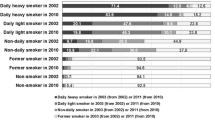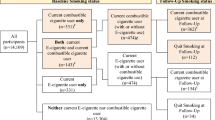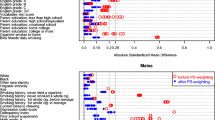Abstract
Background
Understanding differences in cigarette smoking patterns such as the frequency between-person and within-person is essential for tailored tobacco health education interventions. Previous studies, however, mostly limited analysis to computation of cigarette smoking frequency and its correlates. This article used multilevel models to examine between-person and within-person variations in cigarette smoking patterns over a 13-year period.
Methods
We merged the National Longitudinal Study of Adolescent Health public-use data waves 1–4 into one longitudinal dataset for use in this study. Our analysis was based on the past-month’s average number of cigarette smoked per day. We used linear mixed model approach to fit multilevel models.
Results
The average number of cigarette smoked per day (CPD) among the sample at baseline/wave 1 was 6.92 (SD = 8.18). Time of observation in years (β = 0.455 (p < .001), age (β = 0.355, p < .001), past-year alcohol use frequency (β = −0.329, p < .001), and illicit drug use (β = 1.128, p < .001) were associated with average number of CPD. There were significant variations in the average number of CPD between-person (β = 29.602, p < .001) and within-person (variance = 34.393, p < .001).
Conclusions
This study demonstrates that rate of change in average number of CPD over years among the study sample could be different between-adolescent and within-adolescent depending on other substance use and demographic factors. Hence, tailored tobacco use educational programs or interventions and policies targeting these adolescents could be designed according to between-adolescent and within-adolescent differences in the average number of CPD trajectories.
Similar content being viewed by others
Availability of Data and Material
Publicly available data and material at https://addhealth.cpc.unc.edu/data/
References
Alexander, L. A., Trinidad, D. R., Sakuma, K. L. K., Pokhrel, P., Herzog, T. A., Clanton, M. S., ... & Fagan, P. (2016). Why we must continue to investigate menthol’s role in the African American smoking paradox. Nicotine & Tobacco Research, 18(suppl_1), S91-S101.
Alberg, A. J., Brock, M. V., Ford, J. G., Samet, J. M., & Spivack, S. D. (2013). Epidemiology of lung cancer: Diagnosis and management of lung cancer, 3rd ed: American College of Chest Physicians evidence-based clinical practice guidelines. Chest, 143(5 Suppl), e1S-e29S. https://doi.org/10.1378/chest.12-2345
Alberg, A. J., Diette, G. B., & Ford, J. G. (2003). Invited commentary: attendance and absence as markers of health status—the example of active and passive cigarette smoking.
Alin, A. (2010). Multicollinearity. Wiley Interdisciplinary Reviews: Computational Statistics, 2(3), 370–374.
Belsky, D. W., Moffitt, T. E., Baker, T. B., Biddle, A. K., Evans, J. P., Harrington, H., ... & Poulton, R. (2013). Polygenic risk and the developmental progression to heavy, persistent smoking and nicotine dependence: Evidence from a 4-decade longitudinal study. JAMA Psychiatry, 70(5), 534–542.
Bonnie, R. J., Stratton, K., & Kwan, L. Y. (Eds.). (2015). Public health implications of raising the minimum age of legal access to tobacco products. Washington, DC: National Academies Press. Retrieved December 15, 2020, from http://tobacco.cleartheair.org.hk/wp-content/uploads/2015/08/18997-2.pdf
Brook, J. S., Balka, E. B., Ning, Y., & Brook, D. W. (2007). Trajectories of cigarette smoking among African Americans and Puerto Ricans from adolescence to young adulthood: Associations with dependence on alcohol and illegal drugs. American Journal on Addictions, 16(3), 195–201.
Brown, T., Platt, S., & Amos, A. (2014). Equity impact of population-level interventions and policies to reduce smoking in adults: A systematic review. Drug and Alcohol Dependence, 138, 7–16.
Cantrell, J., Bennett, M., Mowery, P., Xiao, H., Rath, J., Hair, E., & Vallone, D. (2018). Patterns in first and daily cigarette initiation among youth and young adults from 2002 to 2015. PloS one, 13(8), e0200827.
Chassin, L., Presson, C. C., Sherman, S. J., & Edwards, D. A. (1990). The natural history of cigarette smoking: Predicting young-adult smoking outcomes from adolescent smoking patterns. Health Psychology, 9(6), 701.
Chassin, L., Presson, C., Seo, D. C., Sherman, S. J., Macy, J., Wirth, R. J., & Curran, P. (2008). Multiple trajectories of cigarette smoking and the intergenerational transmission of smoking: A multigenerational, longitudinal study of a Midwestern community sample. Health Psychology, 27(6), 819.
Chen, P., & Chantala, K. (2014). Guidelines for analyzing Add Health data. Carolina Population Center, University of North Carolina at Chapel Hill, 710. Retrieved on December 16, 2020, from https://addhealth.cpc.unc.edu/wp-content/uploads/docs/user_guides/GuidelinesforAnalysisofAddHealthData_202004.pdf
Choi, W. S., Pierce, J. P., Gilpin, E. A., Farkas, A. J., & Berry, C. C. (1997). Which adolescent experimenters progress to established smoking in the United States. American Journal of Preventive Medicine, 13(5), 385–391.
Fagan, P., Moolchan, E. T., Lawrence, D., Fernander, A., & Ponder, P. K. (2007). Identifying health disparities across the tobacco continuum. Addiction, 102, 5–29.
Garrett, B. E., Dube, S. R., Babb, S., & McAfee, T. (2014). Addressing the social determinants of health to reduce tobacco-related disparities. Nicotine & Tobacco Research, 17(8), 892–897.
Goldade, K., Choi, K., Bernat, D. H., Klein, E. G., Okuyemi, K. S., & Forster, J. (2012). Multilevel predictors of smoking initiation among adolescents: Findings from the Minnesota Adolescent Community Cohort (MACC) study. Preventive Medicine, 54(3–4), 242–246.
Griesler, P. C., Kandel, D. B., & Davies, M. (2002). Ethnic differences in predictors of initiation and persistence of adolescent cigarette smoking in the National Longitudinal Survey of Youth. Nicotine & Tobacco Research, 4(1), 79–93.
Harris, K. M., Halpern, C. T., Whitsel, E., Hussey, J., Tabor, J., Entzel, P., & Udry, J. R. (2009). The national longitudinal study of adolescent to adult health: research design. Retrieved on December 16, 2020, from https://addhealth.cpc.unc.edu/documentation/study-design/
Hu, T., Gall, S. L., Widome, R., Bazzano, L. A., Burns, T. L., Daniels, S. R., ... & Prineas, R. J. (2020). Childhood/adolescent smoking and adult smoking and cessation: The International Childhood Cardiovascular Cohort (i3C) Consortium. Journal of the American Heart Association, 9(7), e014381.
Jamal, A., Gentzke, A., Hu, S. S., Cullen, K. A., Apelberg, B. J., Homa, D. M., & King, B. A. (2017). Tobacco Use Among Middle and High School Students - United States, 2011–2016. MMWR. Morbidity and mortality weekly report, 66(23), 597–603. https://doi.org/10.15585/mmwr.mm6623a1
Johnston, L. D., Miech, R. A., O’Malley, P. M., Bachman, J. G., Schulenberg, J. E., & Patrick, M. E. (2019). Monitoring the future national survey results on drug use, 1975–2018: Overview. Institute for Social Research.
Kandel, D. B., Kiros, G. E., Schaffran, C., & Hu, M. C. (2004). Racial/ethnic differences in cigarette smoking initiation and progression to daily smoking: A multilevel analysis. American Journal of Public Health, 94(1), 128–135.
Kim, J. H. (2019). Multicollinearity and misleading statistical results. Korean Journal of Anesthesiology, 72(6), 558.
King, J. L., Reboussin, D., Ross, J. C., Wiseman, K. D., Wagoner, K. G., & Sutfin, E. L. (2018). Polytobacco use among a nationally representative sample of adolescent and young adult e-cigarette users. Journal of Adolescent Health, 63(4), 407–412.
Liu, S., Rovine, M. J., & Molenaar, P. (2012). Selecting a linear mixed model for longitudinal data: repeated measures analysis of variance, covariance pattern model, and growth curve approaches. Psychological Methods, 17(1), 15.
Maruyama, N., Takahashi, F., & Takeuchi, M. (2009). Prediction of an outcome using trajectories estimated from a linear mixed model. Journal of Biopharmaceutical Statistics, 19(5), 779–790.
O’Loughlin, J. L., Dugas, E. N., O’Loughlin, E. K., Karp, I., & Sylvestre, M. P. (2014). Incidence and determinants of cigarette smoking initiation in young adults. Journal of Adolescent Health, 54(1), 26–32.
Piasecki, T. M., Hedeker, D., Dierker, L. C., & Mermelstein, R. J. (2016). Progression of nicotine dependence, mood level, and mood variability in adolescent smokers. Psychology of Addictive Behaviors : Journal of the Society of Psychologists in Addictive Behaviors, 30(4), 484–493. https://doi.org/10.1037/adb0000165
Saddleson, M. L., Kozlowski, L. T., Giovino, G. A., Homish, G. G., Mahoney, M. C., & Goniewicz, M. L. (2016). Assessing 30-day quantity-frequency of US adolescent cigarette smoking as a predictor of adult smoking 14 years later. Drug and Alcohol Dependence, 162, 92–98.
Sargent, J. D., Gabrielli, J., Budney, A., Soneji, S., & Wills, T. A. (2017). Adolescent smoking experimentation as a predictor of daily cigarette smoking. Drug and Alcohol Dependence, 175, 55–59.
SAS, I. (2013). Base SAS 9.4 procedures guide: statistical procedures. Cary, NC, USA: SAS Institute Inc.
Singer, J. D. (1998). Using SAS PROC MIXED to fit multilevel models, hierarchical models, and individual growth models. Journal of Educational and Behavioral Statistics, 23(4), 323–355.
Sung, H. Y., Wang, Y., Yao, T., Lightwood, J., & Max, W. (2018). Polytobacco use and nicotine dependence symptoms among US adults, 2012–2014. Nicotine & tobacco research : official journal of the Society for Research on Nicotine and Tobacco, 20(suppl_1), S88–S98. https://doi.org/10.1093/ntr/nty050
Sutter, M. E., Everhart, R. S., Miadich, S., Rudy, A. K., Nasim, A., & Cobb, C. O. (2018). Patterns and profiles of adolescent tobacco users: results from the Virginia youth survey. Nicotine and Tobacco Research, 20(suppl_1), S39-S47.
Tanner, T., Päkkilä, J., Karjalainen, K., Kämppi, A., Järvelin, M. R., Patinen, P., ... & Anttonen, V. (2015). Smoking, alcohol use, socioeconomic background and oral health among young Finnish adults. Community Dentistry and Oral Epidemiology, 43(5), 406–414.
Thompson, A. B., Tebes, J. K., & McKee, S. A. (2015). Gender differences in age of smoking initiation and its association with health. Addiction Research & Theory, 23(5), 413–420.
Thompson, C. G., Kim, R. S., Aloe, A. M., & Becker, B. J. (2017). Extracting the variance inflation factor and other multicollinearity diagnostics from typical regression results. Basic and Applied Social Psychology, 39(2), 81–90.
Trinidad, D. R., Gilpin, E. A., Lee, L., & Pierce, J. P. (2004). Do the majority of Asian-American and African-American smokers start as adults? American Journal of Preventive Medicine, 26(2), 156–158.
US Department of Health and Human Services. (2012). Preventing tobacco use among youth and young adults: a report of the Surgeon General. Atlanta, GA: US Department of Health and Human Services, Centers for Disease Control and Prevention, National Center for Chronic Disease Prevention and Health Promotion, Office on Smoking and Health.
US Department of Health and Human Services. (2014). The health consequences of smoking—50 years of progress: a report of the Surgeon General. U.S. Dept. of Health and Human Services, Public Health Service, Office of the Surgeon General, Rockville, MD. Retrieved on October 26, 2020, from https://aahb.org/Resources/Pictures/Meetings/2014-Charleston/PPT%20Presentations/Sunday%20Welcome/Abrams.AAHB.3.13.v1.o.pdf
Yoo, W., Mayberry, R., Bae, S., Singh, K., Peter He, Q., & Lillard, J. W., Jr. (2014). A study of effects of multicollinearity in the multivariable analysis. International Journal of Applied Science and Technology, 4(5), 9–19.
Author information
Authors and Affiliations
Contributions
David Adzrago served as the leading author, conducted the literature review, performed the statistical analyses, drafted the manuscript, and coordinated writing the manuscript. Lucy Kavi coordinated the manuscript writing and provided critical revisions of the manuscript. Rosemary I. Ezeugoh and Bennie Osafo-Darko provided critical revisions of the manuscript.
Corresponding author
Ethics declarations
Ethics Approval
This paper was performed using de-identified public use data and therefore a review from the authors’ Institutional Review Board was not required.
Consent to Participate
Not applicable.
Consent for Publication
Not applicable.
Competing Interests
The authors declare no competing interests.
Additional information
Publisher's Note
Springer Nature remains neutral with regard to jurisdictional claims in published maps and institutional affiliations.
Highlights
• This is the first study to examine between-person and within-person variations in the number of cigarette smoked per day over a 13-year period.
• The rate of change in the average number of cigarette smoked per day was associated with every year increase in the observation period.
• Age was associated with increased average number of number of cigarette smoked per day.
• Illicit drug use was associated with increased average number of cigarette smoked per day.
• Average number of cigarette smoked per day differed among the sample due to between-person and within-person differences.
Rights and permissions
About this article
Cite this article
Adzrago, D., Kavi, L., Ezeugoh, R.I. et al. Temporal Patterns of Cigarette Smoking and Its Associated Covariates: a Multilevel Longitudinal Data Analysis. Glob Soc Welf 9, 121–129 (2022). https://doi.org/10.1007/s40609-021-00220-9
Accepted:
Published:
Issue Date:
DOI: https://doi.org/10.1007/s40609-021-00220-9




